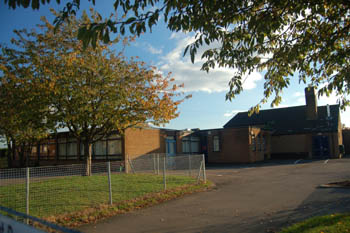Great Barford School
![Elevation of that part of the school nearest the road in 1848 [AD3865/17/3]](/CommunityHistories/GreatBarford/GtBarfordImages/Elevation of that part of the school nearest the r.jpg)
Elevation of that part of the school nearest the road in 1848 [AD3865/17/3]
The ground for Great Barford National School was conveyed free of charge on 7th June 1848 by the Master, fellows and scholars of Trinity College, Cambridge, which held the advowson, to the Vicar, churchwardens and parish of Great Barford [CRT130Bar9]. The site measured one rood, five poles and had been conveyed to the college just six years earlier by the vicar. The site was bounded to the west by Barford Street (the High Street), to which it had a frontage of 97 feet and to the south by gardens occupied by Thomas Cousins and James Robinson, where it measured 100 feet, east by another meadow of the college, where the frontage was 110 feet and north by a lane leading to the premises of Thomas Thody.
The first Education Act was passed in 1870 (more correctly it was known as the Elementary Education Act). It was a milestone in the provision of education in Britain demonstrating central government's unequivocal support for education of all classes across the country. It also sought to secularise education by allowing the creation of School Boards. These were groups of representatives, elected by the local ratepayers and the Board had the powers to raise funds to form a local rate to support local education, build and run schools, pay the fees of the poorest children, make local school attendance compulsory between the ages of 5 and 13 and could even support local church schools, though in practice they replaced them, turning them into Board run schools (known as Board Schools). Naturally, and luckily for local historians, the Act required a questionnaire of local schools in 1870. The National School for Great Barford at that date had accommodation for 132 boys and girls and 64 infants.
![Front elevation of the school extension in 1870 [AD3865-17-5]](/CommunityHistories/GreatBarford/GtBarfordImages/Front elevation of the school extension in 1870 [A.jpg)
Front elevation of the school extension in 1870 [AD3865/17/5]
The school was enlarged in 1870. A new classroom was added at right angles to the building of 1848 [AD3865/17/5]. In 1878 the NationalSchool became a Board school on the creation of a School Board for Great Barford [SB3].
A land mark Education Act was passed in 1902, coming into effect in 1903. It disbanded the School Boards and gave day to day running of education to newly formed Local Education Authorities, usually the county council, as in Bedfordshire. The old Board Schools thus became Council Schools.
Bedfordshire & Luton Archives & Records Service has a scrapbook of cuttings of visits made to most Bedfordshire Schools by School Inspectors for a period from just before the First World War through the inter-war years [E/IN1/1]. The first report in the volume for Great Barford Council School was made in 1912, when average attendance was 120: "The older scholars are in good order and, making allowances for the difficulties under which the School has laboured during the last eighteen months owing to changes in the staff, the condition of the School may be considered creditable to the Master. The Infants, who are taught under great difficulties owing to limited accommodation, are in good order and are satisfactorily taught, but it would be well if babies were excluded unless more space and staff can be provided for them. It is desirable that the older girls should receive more "Hand and Eye" training and lessons in Housewifery and simple Cooking are much needed".
The next inspection was not until after the Great War, in 1921, when the inspector reported he could be accused of damning the school with faint praise: "In this school the order is good and much of the work is of average merit". In 1924 things were improving: "The work of this School as a whole reaches a higher level than when the last report was made" though the inspector made adverse comments about indistinct speech, as he frequently did which a number of schools, he was obviously not much of a fan of the Bedfordshire accent.

The Old School March 2010
In 1928, average attendance 109, it was reported: "This is a well conducted school" the report ending: "The behaviour of the children and the tone of the school are alike good" and a similar report was made in 1934: "This is a well conducted all age school with about 120 children of whom 36 are in the top class; of these 6 were absent on the day of the visit sitting for places in Secondary Schools. A good many were also absent owing to tonsilitis, and the Teacher of the Standards I and II was absent, her place being filled by a Supply Teacher. The work of the Infants is in all respects promising, and that of the Second Class is in some ways striking: the teacher's illustrations and her manner of giving lessons has roused much interest in the work in general, and in Nature Study in particular. The new syllabus of Physical Exercises is well on the way in all the classes. Singing in the top class is very pleasing. the Head Master's examinations are full, show good work, and sensible marking. Speech throughout the school is clearly articulated but, among the boys in particular, is somewhat spoilt by wrong vowel sounds. The condition of the school is creditable to all concerned".
The third of the great Education Acts was that of 1944 which established the principle of County Primary Schools for children up to the age of 11, at which time they took an examination to determine the nature of the secondary school they would attend until they were 15, the most academically able going to grammar schools, the rest to secondary or secondary modern schools. Great Barford Council School thus became Great Barford County Primary School.
In the 1970s Bedfordshire County Council introduced comprehensive education, doing away with the 11+ examination and grammar schools and introducing a tier of school between the old County Primary and County Secondary Schools. Thus Lower Schools now taught children aged 4 to 9, Middle Schools from 9 to 13 and Upper Schools from 13 onwards. GreatBarfordCounty primary School thus became Great Barford Lower School. New school buildings were erected in Silver Street adjacent to Alban V. A. Middle School and the lower school began to move in February 1981, the official opening being on 21st May that year. The older school buildings were then given up [SDGreatBarford8]. In 1995 it was proposed that the old school buildings be converted into a nursing home [PCGreatBarford18/41] but at the time of writing [2010] they are private dwellings.
 Great Barford Lower School October 2007
Great Barford Lower School October 2007